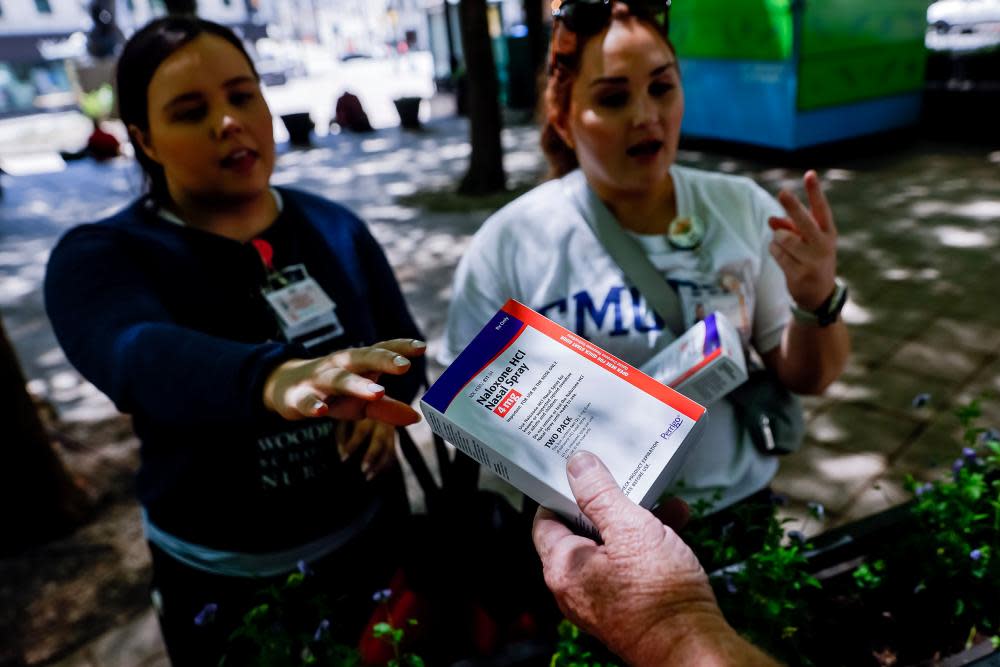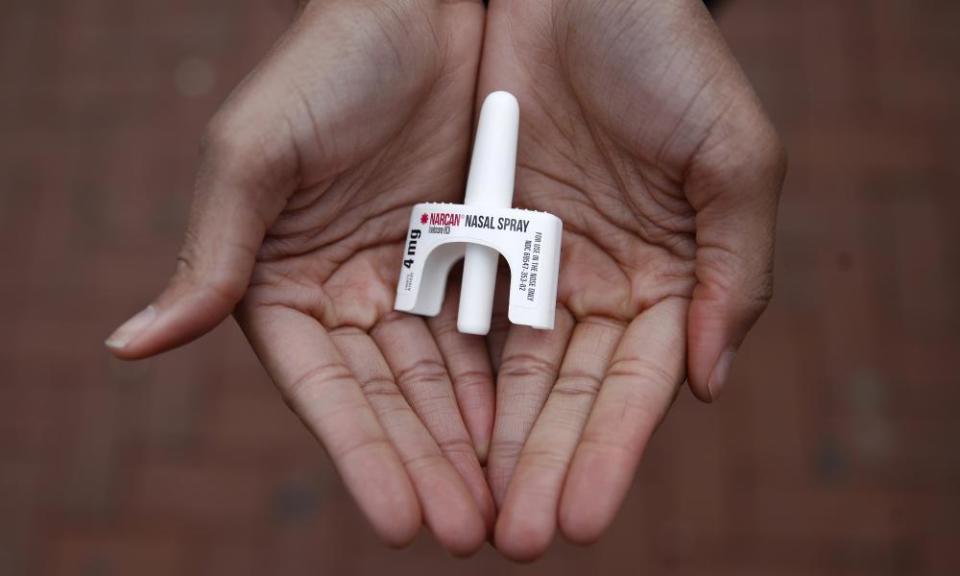‘I yelled, “I’m putting this up your nose”’: what it’s like to use Narcan

Over 100,000 Americans died of drug overdoses last year. Advocates say a vast number of them might still be alive if they’d had access to naloxone. Brandon Kilmer, a 24-year-old from Minneapolis, lost his brother to a fentanyl overdose in 2022. Now, he distributes a pack of Narcan to everyone he meets. “I don’t care if you’re a 17-year-old kid or an 80-year-old grandmother,” he said. “I want you to have it.”
Naloxone, better known by the brand name Narcan, reverses overdoses by binding to the opioid receptors in the brain, blocking the effects of drugs such as fentanyl or heroin. Harm reduction workers say it should be as ubiquitous in Americans’ homes as dental floss or hand sanitizer, but not enough people have access to it.
The FDA recently approved selling naloxone over the counter. By late summer, it could be on shelves at convenience stores, supermarkets, and other retailers that do not have a pharmacy.
The Guardian spoke with four people who have used Narcan to reverse overdoses. All of them said it was a quick and intuitive process that was easy to follow, even in the most emotionally intense situation.
‘I saw a man lying on the sidewalk. I thought: “I guess this is it”’
Dvorah, 52, Los Angeles, researcher
My brother died of an opioid overdose. After he passed, I went to an organization in LA called Being Alive, where they gave me Narcan. I’ve carried it in my car ever since. I never thought I’d actually use it. I’m 52. I’m not in the party scene any more. But why not have it?

A few weeks ago, I was in my car driving to the freeway. It was a few days before the anniversary of my brother’s death. He was on my mind. As I drove, I saw a man lying on the sidewalk. But it didn’t seem like the type of place you’d go to sleep if you were homeless or passed out drunk – it didn’t look comfortable.
I just had a feeling. I stopped my car, and I went up to him and said, “Hey buddy, are you OK?” I didn’t get a response. He was wearing a big hoodie that covered most of his body, so I pulled his hood back and saw that he was breathing, but the breath was shallow.
I thought, “Well, I guess this is it.” I ran to my car, got the Narcan, and literally yelled in his face, “I am going to put this up your nose.” After one spray, he slowly opened his eyes. He turned over, said he needed to use the bathroom, and then he peed.
I showed him the spray and asked if he knew what it was for. He did, and we waited for the ambulance together. We didn’t really talk, but I put an extra Narcan on his backpack, in case he needs it. The EMTs came, and that was it. I went back to my day.
It was unbelievable to do this so close to the anniversary of my brother’s death. I’d been thinking about him all week, so using Narcan to reverse an overdose was a wild coincidence. I couldn’t save my brother, but I was able to help someone else.
‘I lost friends to overdoses. If we’d had Narcan, maybe they’d be here’
Rissy, 38, Saskatoon, Saskatchewan, Canada, who posts about naloxone on the TikTok @harmreductionrissy
I spent 20 years in the throes of addiction, so harm reduction work comes naturally to me. I lost a partner and friends to overdoses years ago, back when no one was talking about Narcan. If we had it back then, maybe they’d still be here.
In 2019, I finally got my hands on some intramuscular naloxone through an overdose prevention organization. So it wasn’t a spray, it was a needle you injected. The first time I used it, I had to administer it through a man’s jeans, into his thigh. The syringe actually bent on my first try. I could have freaked out, but I didn’t. I just drew up another syringe, and thank god that one went in. I remember getting shaky from the adrenaline. But I also knew what I had to do. It’s instinctive. Your body takes control and goes through the motions of administering it.
When the man came to, he was very confused. I explained what happened to him, and he got angry because I had taken his high away from him. I kept explaining to him that he was safe, and I wouldn’t call the police. I tried to keep him around me for 20 minutes, to make sure the overdose wouldn’t come back, but after a while he left.
Once, I had to administer Narcan to someone I knew. And that was extra scary, because it was personal. It felt like I was moving in slow-motion. There was this intense sense of urgency. When my friend woke up, they were embarrassed, ashamed, and apologetic. But they shouldn’t have to feel that way.
There’s this huge conversation that if you use Narcan, you’re just enabling someone to use drugs more. But that’s not true – you’re giving them a chance at recovery. Narcan keeps people alive. Dead people can’t recover.
‘You’d walk down the street and find people overdosing every day’
Brandon Kilmer, 24, Minneapolis, Minnesota
I’ve used Narcan 11 times, that I remember. I used to use drugs, and in 2017 fentanyl took over the heroin supply in Minneapolis. You’d walk down the street and find people overdosing every day. It was death after death after death. So when people started to learn about Narcan, I went to my doctor and told him I needed it, not just for me but for my friends and those strangers on the street.
Every time I do it, I enter this weird state of autopilot. It’s like riding a bike: you have to pick it up and learn how to do it, and then you never forget. The first time I used it, it was to help a man on the bus who had OD’d.
One thing I’ve learned is that when you call an ambulance, it’s best not to mention that you’re dealing with an overdose. Just say you’re with an unresponsive person. There’s just so much stigma around drugs that it’s easier that way. I’ve seen rescue services not show up at all when you mention an “overdose” and having already administered Narcan.
My brother was addicted to fentanyl. You’d have never known it, though. He went to school, he worked, he was in a trade union. I used Narcan on him once when he was 18 and living at home. He ended up in the hospital, but he got out the same night, came home, and used again. So, once more, I had to repeatedly Narcan him until the police showed up. He landed in the ICU, where he was sedated and intubated for five days. He was in a coma until he regained function of himself.
Later on, my brother and his girlfriend moved into a new place. Things looked good for them, and it felt like he was starting his life as an adult. But he was still addicted to fentanyl, and he used alone. You always want someone to be around, just in case anything happens. But people can feel invincible, I guess. On 29 March 2022, my brother overdosed. He passed away around 11pm at night, and nobody found him until noon the next day.
I used to use drugs myself. Now, I want to be part of the solution. That’s why I always make sure everyone I meet carries Narcan. I don’t care if you’re a 17-year-old kid or an 80-year-old grandmother, I want you to have it.
‘You just put it up the nostril and push the plunger’
Ruth Hollenback, 26, Denver, Colorado, restaurant server, harm reduction specialist, and co-founder of the street outreach organization Colfax Cats
A few years ago, I was in Union Station, right in the center of downtown Denver. As I was heading to my train, I saw security guards standing around this man, just watching him, as he was passed out on the ground. I was interning at a syringe exchange at the time, so I walked right up and asked, “What’s going on?” The guards were acting very nonchalant, and they said he wasn’t breathing. They had called the paramedics, but otherwise there was no sense or urgency.
I was kind of flustered, but it’s simple to administer nasal spray: you just put it up the nostril and push the plunger. It’s sort of anticlimactic. My heart was beating very fast, but it was such a serious situation I just focused on what I needed to do.
Related: Naloxone has been hailed as life-saving. Why isn’t it given to those who need it?
After I gave the man Narcan, he moved a little bit. There is this myth that everyone who gets Narcan will be aggressive and violent, but that’s not true. This man just looked confused. My friends who have been Narcaned have told me that it’s a very unpleasant experience, because the drug basically kicks you into withdrawal. So you’re going to be very dopesick, which feels crappy. They might be pissed at you for doing that. But I’d rather someone be pissed at me and still be alive.
I stayed with him until the EMTs came. After that, it was back to my normal day – I just headed into work. I think I texted the person who taught me how to use Narcan telling them I’d done it, and they were very supportive. The organization I worked for later reached out to the station’s security company, and we gave the guards Narcan training.
Now I work at a diner on a really busy street with a lot of drug use. A few weeks ago, someone came in asking for me.They must have known my name from the mutual aid organization I’m part of. I was in the dish pit, but I went out to say hi and they were very short and to-the-point. They asked if I had Narcan. I did, and I gave it to them, and the person who was overdosing behind the diner ended up OK.
People love to throw Narcan around as some kind of solution to the drug war, which it isn’t. The real solution is a safe and regulated drug supply. But Narcan is a beautiful resource that is free and legal and can easily save someone’s life. Why wouldn’t you carry it?

 Yahoo News
Yahoo News 
